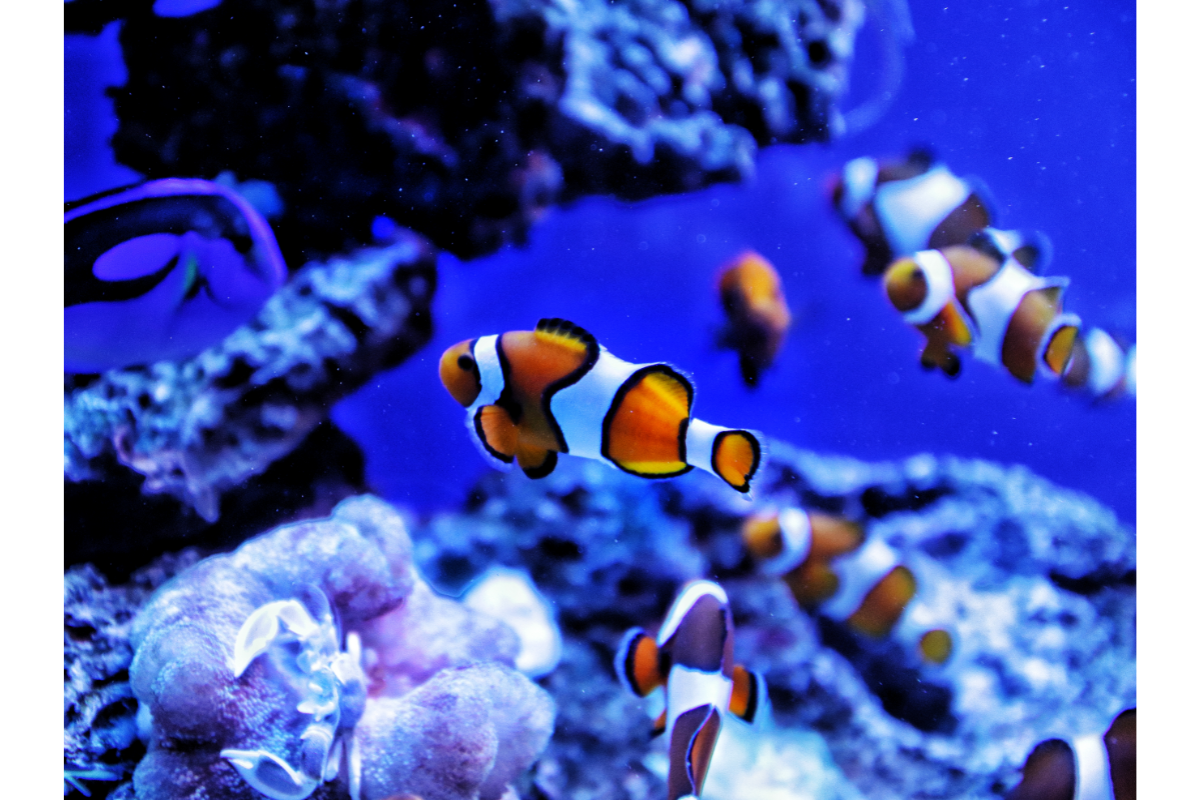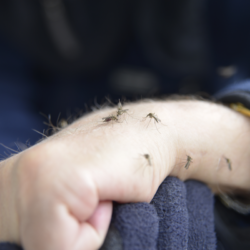Mycobacterium marinum skin diseases represent a growing diagnostic and therapeutic challenge in the field of medical dermatology. This infection results from exposure to common mycobacteria found in aquatic environments. It is also recognised as a zoonosis. It often affects people in direct contact with infected animals or their environment.
What does the disease look like in animals?
Infection with Mycobacterium marinum, often referred to as “fish tuberculosis”, mainly affects aquarium and farmed fish species, particularly tropical species. Less frequently, the disease can also infect turtles, crocodiles and frogs. This infection is found worldwide in both freshwater and saltwater aquatic environments. Its frequency remains unknown.
Mycobacterium marinum is mainly transmitted through the ingestion of contaminated food or the detritus of aquatic animals. It can also occur through inoculation of the skin. Symptoms of skin infection may initially go unnoticed for many years. Later, they may manifest as skin lesions such as scale loss, ulceration, discolouration, swelling of the abdomen or exophthalmos. In acute cases, the infection can lead to sudden death.
Diagnosis of tuberculosis in fish is often difficult due to non-specific symptoms, requiring time-consuming and costly laboratory tests. The most susceptible species in aquaria include cyprinids, cichlids, characids, labyrinthids and marine species. The treatments available are limited, and the infection is often fatal for the fish affected. Because of the zoonotic risk and the resistance of Mycobacterium marinum to conventional treatments, treatments based on sulphonamides and antibiotics are recommended and reserved for specialist veterinary surgeons. Immediately after detection, it is recommended that infected fish be isolated. The aquarium should be thoroughly cleaned to prevent the infection spreading.
How is it transmitted from animals to humans?
Contamination by Mycobacterium marinum generally occurs through contact with a wound or bite (e.g. a fish bone). This exposes fishermen to an occupational risk. At present, it is mainly contracted when aquarists handle fish without using protective gloves, or when cleaning aquariums. In the past, it was associated with epidemics of granulomas after swimming in pools. This mode of transmission has been reduced thanks to better chlorination of swimming pools.
A retrospective study was carried out in Thailand on 123 cases of skin infections caused by atypical mycobacteria. It revealed that 65% were attributable to M. fortuitum/chelonae and only 30% to M. marinum. M. marinum is solely responsible for damage to the extremities. However, in France, it is estimated that M. marinum accounts for almost half of all mycobacterial infections. On the other hand, it is rarely identified in the laboratory because of its clinical rarity.
The average incubation period for the disease is around 2 weeks. Mycobacterium marinum is transmitted via a wound or contact with even a minor skin lesion on an infected fish, or contaminated equipment or water (aquarium, swimming pool, etc.).
How does it affect humans?
In France, there are several dozen cases a year of skin lesions caused by Mycobacterium marinum.
There are three main forms of manifestation:
- Protruding soft skin lesions are often referred to as “aquarium granuloma” or “swimming pool granuloma”. They progress to ulceration, mainly affecting the hands and forearms. If left untreated, they can lead to serious infections of the tendons of the hand.
- Less frequent cases of generalised infection occur, especially in immunocompromised individuals. The initial lesion, which is often papulonodular and painless, is located mainly at the point of inoculation, generally on the extremities, such as the upper limb in the case of “aquarium disease”, or sometimes on the lower limb in the case of “swimming pool granulomas”. Lesions can develop in a variety of ways, becoming ulcerated, abscessed, verrucous or vegetating, with a linear arrangement on the limb along the lymphatics, characteristic of the sporotrichoid form.
- Osteoarticular complications, particularly of the hands, are fairly common, encouraged in particular by the use of corticosteroids. Involvement of lymph nodes is rare, and systemic dissemination is exceptional. This complication has been observed in children with haemopathy and in HIV-infected individuals.
Symptoms include strings of nodules on the extremities, painless and resistant to conventional treatments, with papulo-nodular lesions that may ulcerate, suppurate or become keratotic. These nodules follow a sporotrichoid pattern along the lymphatic drainage, characteristic of the disease. Complications can affect tendons, synovial sheaths and joints, leading to amputation.
Diagnosis is often delayed due to the rarity of the infection and the omission of aquatic exposure. It requires a high index of suspicion, with a detailed history and a specific culture for Mycobacterium marinum. DNA-based detection methods are also used to classify mycobacteria.
Zoom in on the Mycobacterium marinum bacterium
Mycobacterium marinum is an aquatic bacterium belonging to the family of atypical mycobacteria. It is responsible for opportunistic infections in humans. It is a zoonosis transmissible from fish to humans, but is generally not fatal for immunocompetent individuals and heals spontaneously in most cases.
This microorganism takes the form of bacilli around 4 μm long, with a zebra-like appearance.
M. marinum is widespread throughout the world, colonising various aquatic environments such as fresh and salt water. It also infects cold-blooded animals such as fish, amphibians and various reptiles, both healthy and diseased. Although infections have been reported in other animal species such as cattle, pigs, European hedgehogs and Amazonian manatees, M. marinum is primarily recognised for its role as a zoonosis affecting humans.
M. marinum was first isolated in 1926 by Joseph D. Aronson, from a diseased fish. Linell and Norden did not identify it as a human pathogen until 1951. In the past, human infections linked to this atypical mycobacterium were often associated with swimming. However, their incidence has fallen considerably in swimming pools thanks to improved construction and maintenance practices.
The first case of infection associated with a fish tank was reported in 1962. Tuberculosis in fish is considered an occupational hazard for certain categories of workers, particularly amateur aquarists, in whom most infections occur. Symptoms of cutaneous infection with M. marinum may include non-specific lesions, often requiring histological examination for confirmation. Colonies of this bacterium, obtained in culture, have distinctive features such as a mucous appearance and a yellow colour.
How is the disease diagnosed?
Diagnosis of Mycobacterium marinum skin disease is often delayed, largely due to the rarity of the infection and the lack of recognition of aquatic exposure. A high level of suspicion and a detailed history are crucial in establishing the diagnosis of M. marinum infection. Excessive delay in diagnosis can result in serious harm. In the laboratory, M. marinum grows on a Lowenstein-Jensen slope at 30-33°C in 7 to 21 days, presenting a cream to yellow coloration on exposure to light (photochromogenic). Unlike M. tuberculosis, most strains of M. marinum do not grow at the usual incubation temperature of 37°C. Once cultivated, M. marinum is easily identifiable by conventional methods of characterising mycobacteria, being distinguished in particular by its photochromogenicity and relatively rapid growth (1 to 2 weeks).
Medical questioning should reveal any potential exposure to aquariums, swimming pools or bodies of water by the patient. Diagnosis of M. marinum infection is complex and may take several months, as it is generally based on specific tests for this bacterium. Samples taken to test for M. marinum are generally taken from the skin, but may also be taken from lymph nodes or synovial fluid. As the test for acid-fast bacilli (AFB) is unreliable, only culture can confirm the presence of M. marinum. As M. marinum does not grow well at 37°C, cultures should be taken at 30°C.
Cultures can sometimes prove negative. Nevertheless, the diagnosis can be made on the basis of clinical signs supported by typical histological features. Because M. marinum is a common skin infection caused by an atypical mycobacterium, various DNA-based techniques are used to classify it. The differential diagnosis includes several other skin conditions, often requiring histological examination to confirm the presence of tuberculoid granulomas.
What is the treatment?
Preventing contamination
Collective preventive measures against Mycobacterium marinum skin infections are essential to reduce the risk of transmission for both animals and humans. For animals, we recommend :
- isolate fish before introducing them into a communal aquarium,
- quickly remove moribund or dead animals,
- regularly check water quality
- and avoid overpopulation.
Appropriate resources such as drinking water, soap, single-use wiping equipment and first-aid kits must be in place. Separate lockers are also recommended to prevent contamination of personal belongings, and appropriate work clothing and personal protective equipment must be worn, in good condition and well maintained.
In the event of an animal disease, reinforcing farm hygiene is crucial, as is signposting and limiting access to infected areas. We also recommend:
- sick fish should not be treated
- destroy infected batches
- disinfect aquariums and their contents,
- dispose of contaminated sand,
- and to take additional precautionary measures such as wearing gloves and boots when working with fish.
The Fédération française d’aquariophilie recommends a number of simple measures to combat these infections. These include following the rules of hygiene, regular maintenance of the aquarium and disinfection of accessories. It is also crucial not to bring wounds into contact with any part of the aquarium. Possible sources of contamination should be minimised. Finally, it is recommended that gloves and boots be worn when working with food fish, that hygiene rules be observed, and that hygiene instructions be reinforced if animal disease is detected.
What is the status of the disease?
Although Mycobacterium marinum is not highly transmissible between animals, it does not present a high risk of propagation in animal populations. Consequently, it is not listed as an important contagious disease in the field of animal health.
In terms of public health, although Mycobacterium marinum can cause skin infections in humans, it is not a notifiable disease. This means that cases are not systematically reported to the health authorities. This could lead to an underestimation of the true incidence of this condition.
On the other hand, from the point of view of compensable occupational diseases, Mycobacterium marinum is recognised as a potential cause of occupational disease. Workers exposed to contaminated aquatic environments can contract this infection, particularly those working in the fishing, aquaculture or aquarium maintenance sectors. In France, this condition is specifically listed in table 16 of the agricultural scheme and table 40 of the general scheme. This enables sufferers to receive compensation for the consequences of their illness.
The classification of Mycobacterium marinum in hazard group 2, under article R.4421-3 of the French Labour Code, highlights the need for appropriate preventive measures to be taken in exposed workplaces. This includes strict safety protocols, such as the wearing of personal protective equipment and the implementation of rigorous hygiene practices, to reduce the risk of infection among workers.





